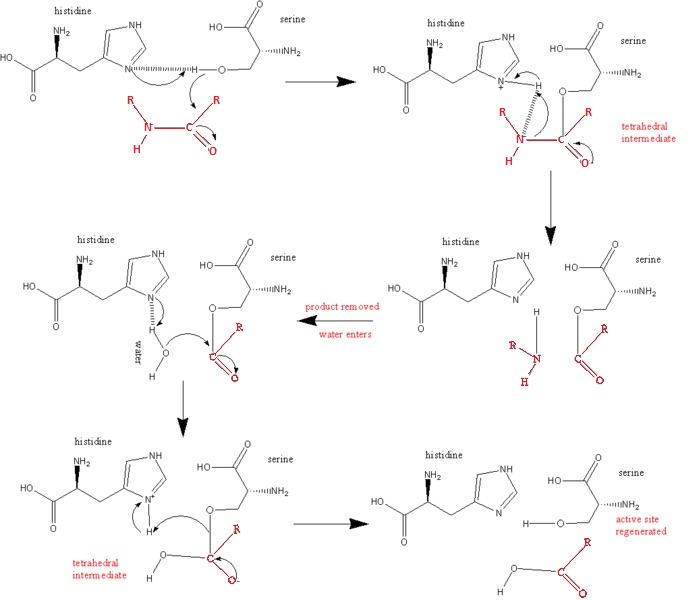Sandbox Wabash13
From Proteopedia
(Difference between revisions)
| Line 10: | Line 10: | ||
2. Acid catalysis breaks the tetrahedral intermediate through cleaving of the scissile peptide bond to form an acyl-enzyme intermediate. His 57 donates a proton by general acid catalysis. | 2. Acid catalysis breaks the tetrahedral intermediate through cleaving of the scissile peptide bond to form an acyl-enzyme intermediate. His 57 donates a proton by general acid catalysis. | ||
| - | This is aided by | + | This is aided by Asp 102 polarizing effect on His 57. This causes the tetrahedral intermediate to decompose to the acyl-enzyme intermediate. |
| - | 3. The amine product is replaced by H2O and subsequently released from the enzyme/substrate complex. | + | 3. The amine product is replaced by H2O and subsequently released from the enzyme/substrate complex. |
| + | R'NH2 is the new N-nterminal portion of the cleaved polypeptide chain. (See Diagram Below) | ||
| - | 4. Base catalysis by enzyme | + | 4. Base catalysis by enzyme. The Acyl Intermediate,highly susceptible to hydrolytic cleavage, adds water to yield a secondary tetrahedral intermediate. |
| + | H2O forms a covalent bond with the carbonyl group of the N-terminal peptide, leading to another tetrahedral intermediate | ||
| + | |||
| - | 5. Acid catalysis by the breaking of the C-O covalent bond of the tetrahedral intermediate, releasing the peptide from the enzyme substrate complex. Once the peptide is released, the enzyme once again becomes active. <ref>PMID:16636277</ref>. | + | 5. Acid catalysis by the breaking of the C-O covalent bond of the tetrahedral intermediate, releasing the peptide from the enzyme substrate complex. Once the peptide is released, the enzyme once again becomes active. |
| + | By yielding a carboxylate product ( C-Terminal portion of the cleaved polypeptide chain) that regenerates the active enzyme | ||
| + | |||
| + | <ref>PMID:16636277</ref>. | ||
Revision as of 01:37, 19 February 2016
Trypsin Mechanism & Structure - Chase Francoeur, Elias Arellano
| |||||||||||

